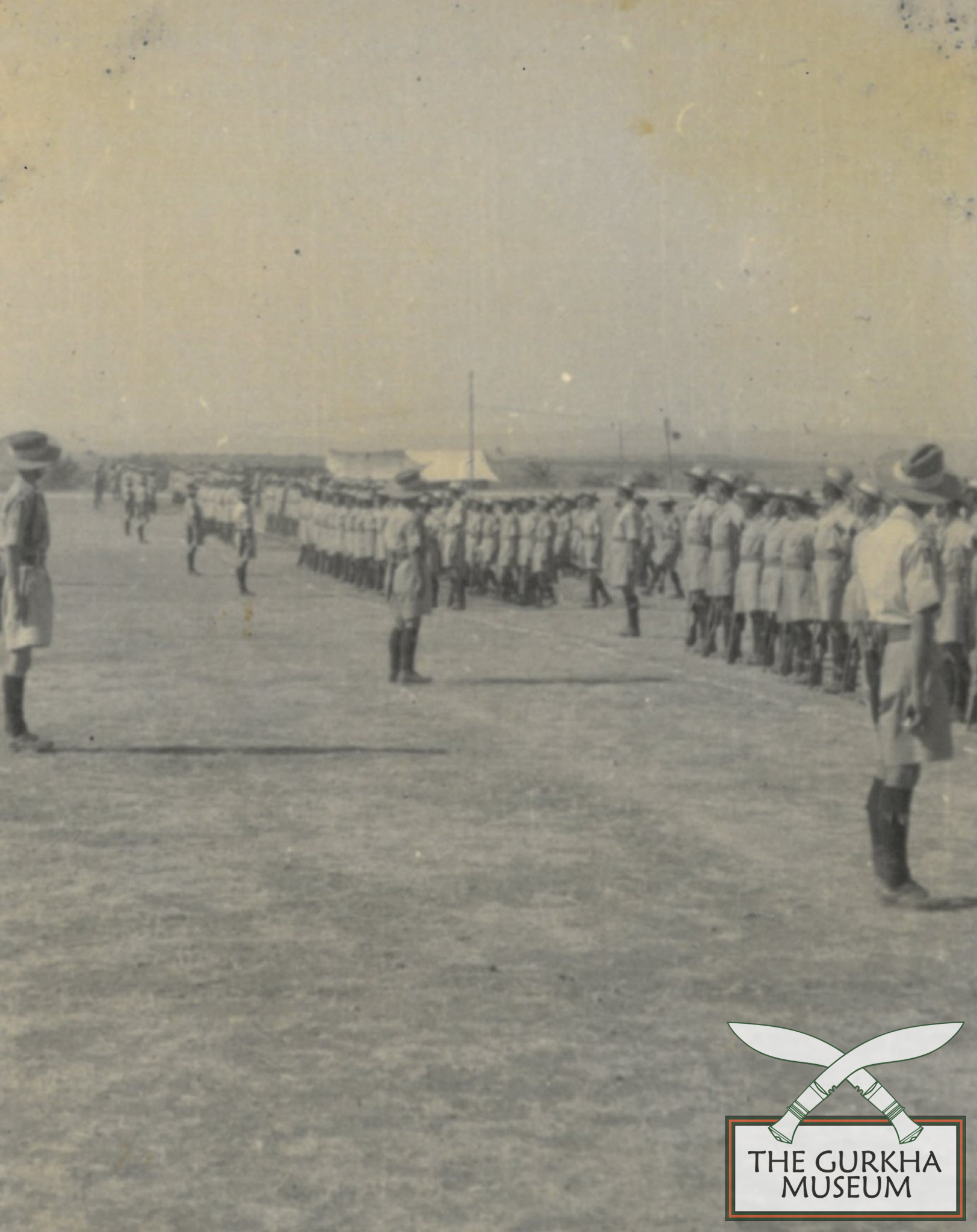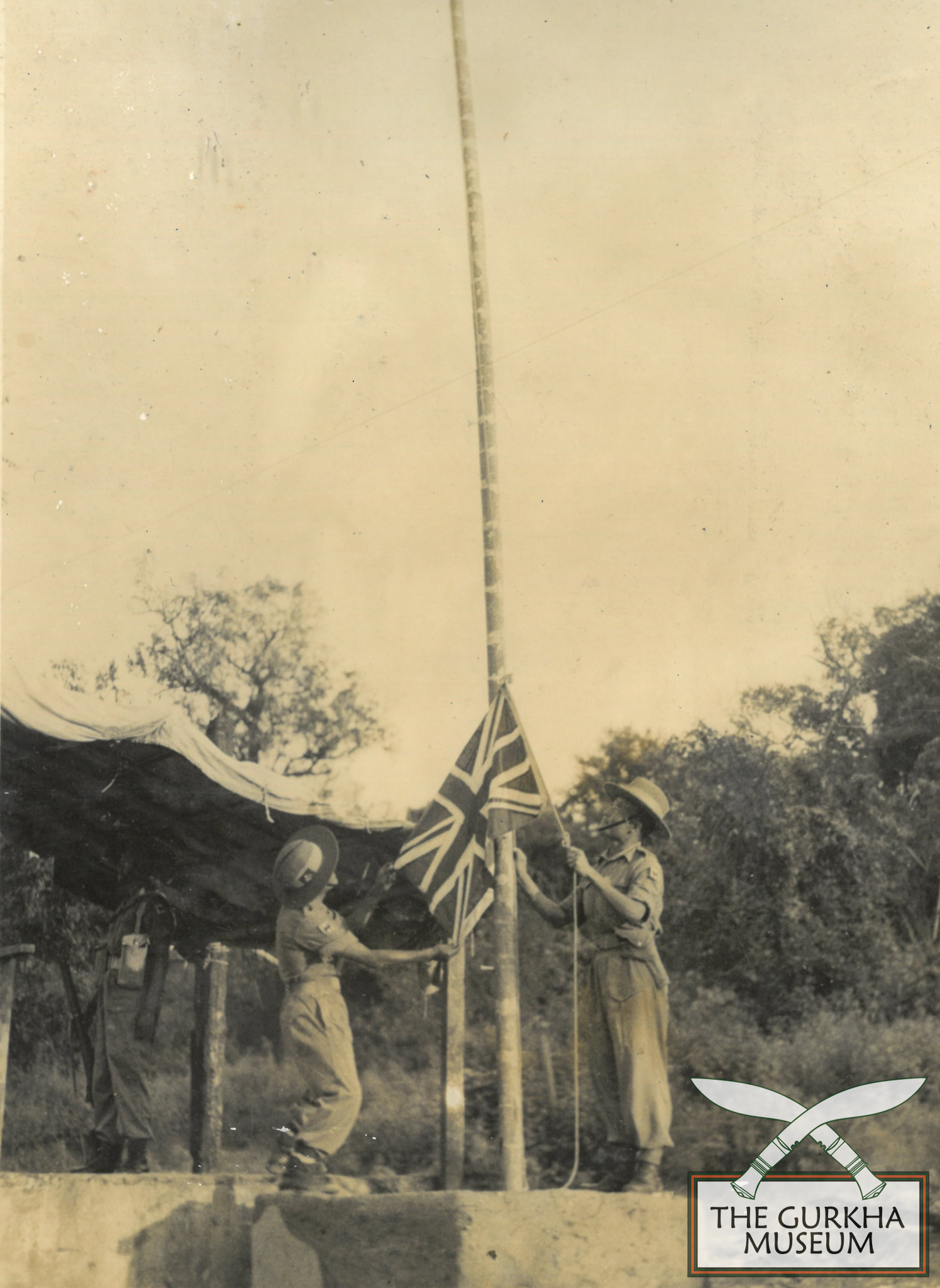But despite the rapidly deteriorating situation, surrender was far from the minds of many Japanese generals. Deep-seated taboos around surrender, and fear that capitulating to the Allies would see the Emperor removed from power, convinced many within the Japanese government that the only honourable course was to fight until the end. Japan’s Supreme War Council was deadlocked on the issue until 14 August, when Emperor Hirohito addressed them personally. To a weeping audience, Emperor Hirohito informed them of his intention to surrender, and that he would make a broadcast to the Japanese people.
On 15 August 1945, the Emperor’s speech was transmitted to the populace. Lamenting that the war effort was developing ‘not necessarily to Japan’s advantage’, he accepted the terms of surrender laid out by the Allies and ordered his armies to cease hostilities. After six years of bitter fighting, the Second World War had finally ended.
A Hard-Won Victory
In August 1945, Britain’s Gurkha soldiers were spread across Europe, the Middle East and southeast Asia. For the Gurkhas serving in Europe, their war had ended in May. Nevertheless, the news that Japan had surrendered, and that they would not be required to join the fighting in the Far East, caused great celebration. To mark the end of the war the 2nd Battalion, 4th Gurkha Rifles, stationed in Italy, entertained the local people with a traditional ‘nautch’ dance. The Gurkhas also provided them with supper, which was much appreciated as there were severe food shortages in the area.

Soldiers of the 2nd Battalion, 7th Gurkha Rifles, stationed in Greece, mark Victory over Japan with a special parade, August 1945
But as Allied nations erupted into celebration, for many on the frontlines the end of the war elicited a much more subdued response. Throughout July and August, the 1st, 3rd and 4th Battalions of the 6th Gurkha Rifles had been fighting along the Sittang river in Burma, where British and Indian forces were blocking a desperate breakout attempt by the Japanese 28th Army.
Despite the success of their operations, the Gurkhas could take little satisfaction from their victory. The Japanese in front of the 1st Battalion, 6th Gurkha Rifles were so weakened by hunger and disease that they were barely able to fight. Indeed, frontline conditions were miserable, with the Gurkhas operating among flooded, corpse strewn paddies. The battalion would celebrate properly a few months later by holding a special Dashain celebration, during which they consumed a ‘record volume of rum’. On the last day of the celebration the battalion held a remembrance parade to honour the men they had lost.
The 4th Battalion, 6th Gurkha Rifles were in reserve when hostilities ceased, preparing to be relieved by the King’s African Rifles. The officers were called into a conference to be told the news. The moment was described in their regimental newsletter: ‘Knee deep in slush and slime, in a penetrating permanent drizzle, soaked through, we were gathered in the shelter of a tarpaulin around the glimmer of a battered lantern. A gunner came in and assured us the war was over. We gave him our last tot of rum, and that was that.’ As anti-climactic as the end of the war proved to be for some soldiers, they were at least properly informed.
Some battalions, deep in the fog of war, received much less reliable information. The officers of the 1st Battalion, 1st Gurkha Rifles were told that the war had ended a full week before it actually had, and had even celebrated the news with a night of drinking and songs. It was only the following morning that the battalion learned that not only was the war still on, but that they were required to send out a large patrol to counter rumoured Japanese activity. Fortunately, the battalion suffered no further casualties before the war actually ended.
Over the following weeks, Gurkha units set to the task of collecting and disarming Japanese prisoners. On 24 August, Japanese emissaries met with officers of the 1st Battalion, 10th Gurkha Rifles (1/10GR), where the two sides negotiated ceasefire conditions. Despite their previous enmity, the two sides co-existed peacefully in their sector over the following weeks.

Japanese soldiers in the Sittang area after being disarmed by the 10th Gurkha Rifles
Whilst relations in 1/10GRs sector were peaceful, some isolated groups of Japanese soldiers were not aware that their government had surrendered. Dalbahadur Khatri was in Malaya when the war ended, serving with Force 136. This specialised unit had parachuted into Japanese occupied Malaya to assist local resistance groups. Later recounting his war experiences to Lieutenant Colonel John Cross, Dalbahadur reported that his unit suffered a fatality in late-August 1945 when a group of Japanese soldiers opened fire on them, killing a Havildar named Ranbahadur. Fortunately, contact was eventually established with the Japanese, and the attacks ceased.

Japanese officers surrendering their swords, c. September 1945.
The Cost
Approximately 130,000 Gurkhas served during the Second World War, making a tremendous contribution to the ultimate victory over Axis forces. Sadly, this contribution came at a steep cost. The Gurkhas suffered approximately 20,000 casualties during the war, including over 9,000 dead.
It was the Far East theatre that saw the greatest number of Gurkha casualties. To take one battalion as an example, 1/10GR recorded 158 Gurkhas killed in action between 1942-1945, with a further 75 dying from wounds and disease. Gurkhas fighting in Europe fared no better, with the 2nd Battalion, 6th Gurkha Rifles having suffered 560 casualties during its campaign in Italy.
But regardless of casualties, the Gurkha fighting spirit remained high right until the end of the war. In fact, among the men of the 3rd Battalion, 6th Gurkha Rifles there was some disappointment that the war had ended, as they were hoping to carry onto Malaya and give the Japanese ‘a real thrashing’.
Although there would be no more battles against the Japanese, the end of the war did not mean the end of active service for some Gurkha battalions. In late-1945, conflicts broke out in Java and Indochina as militia groups who had resisted the Japanese now sought to prevent the return of colonial authority. Several Gurkha battalions would be pulled into the fighting, in many cases seeing combat as intense as any they’d faced during the war. Other Gurkhas would undertake occupation duties in Japan, remaining there until August 1947.
For many, the end of the war meant the surreal prospect of returning to civilian life, and the boundless possibilities that came with it. Although just 20-years old, Major Patrick Davis of the 4th Battalion, 8th Gurkha Rifles had become accustomed to the idea that he might be killed at any moment. When the fighting ended, he found that he was able to ‘dare’ to imagine the future: ‘We had to adjust to a new time scale, one that looked at the future as months, years, not hours, days. Tomorrow could be 1946 as well as Friday’.
Since January 2025, this article series has sought to highlight the invaluable contribution that the Gurkhas made in the Second World War, and to recognise that the future that Davis contemplated in 1945, and the 80-years of global security that we have enjoyed, was in part paid for by the Gurkha soldiers who walked the long path to victory.

Two men of the 10th Gurkha Rifles raise the Union Jack over the Sittang river, Burma, August 1945.
……………….






